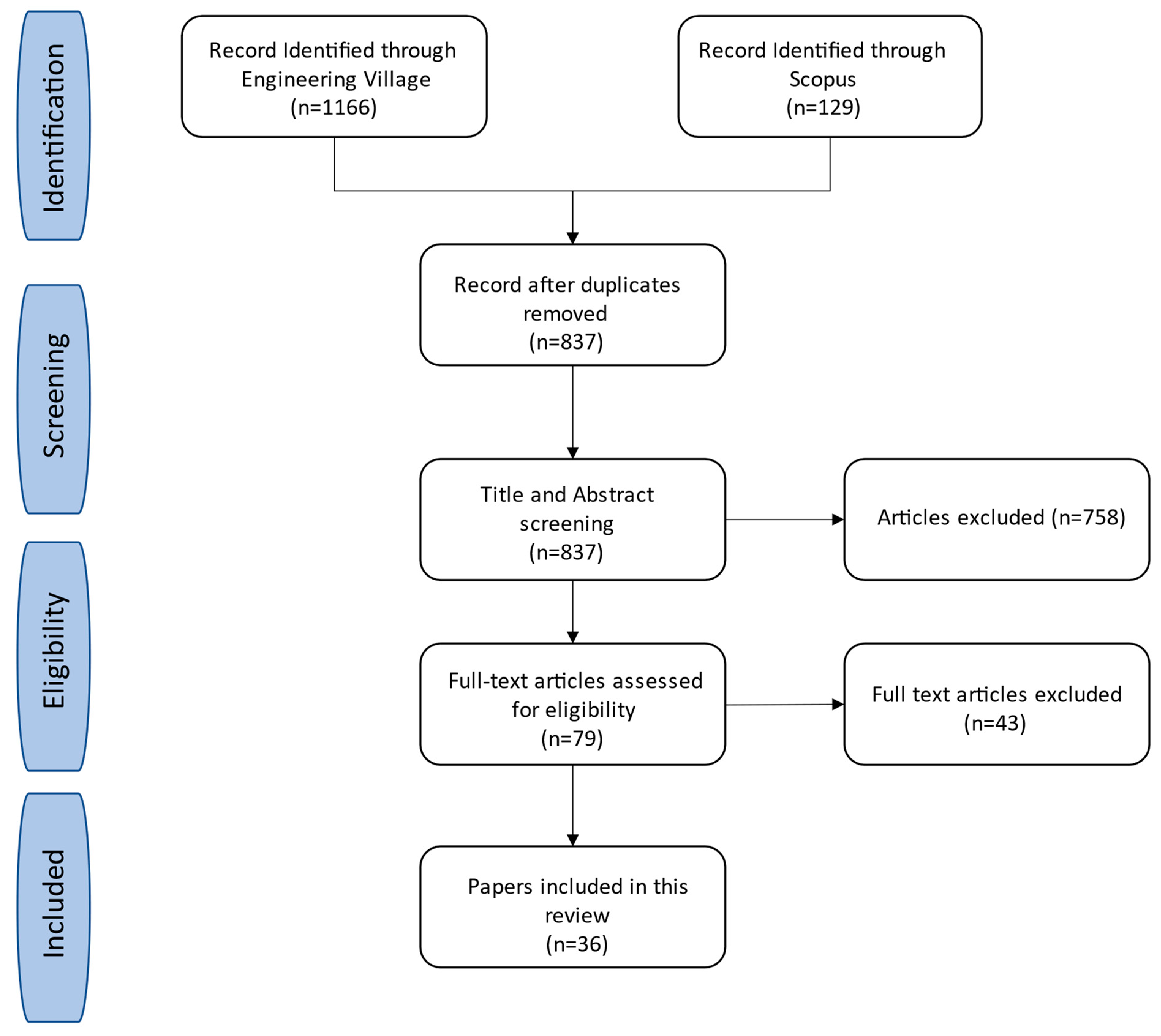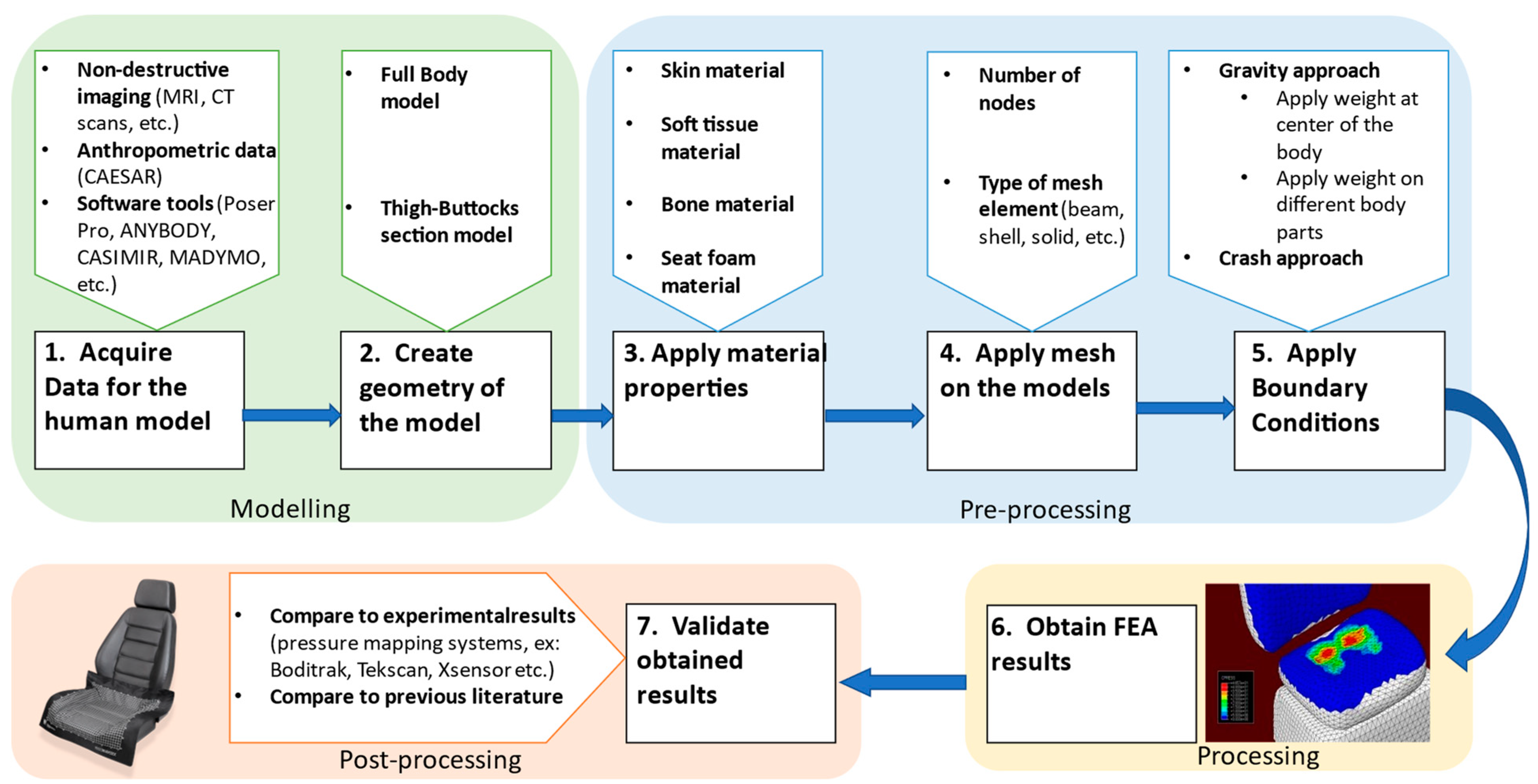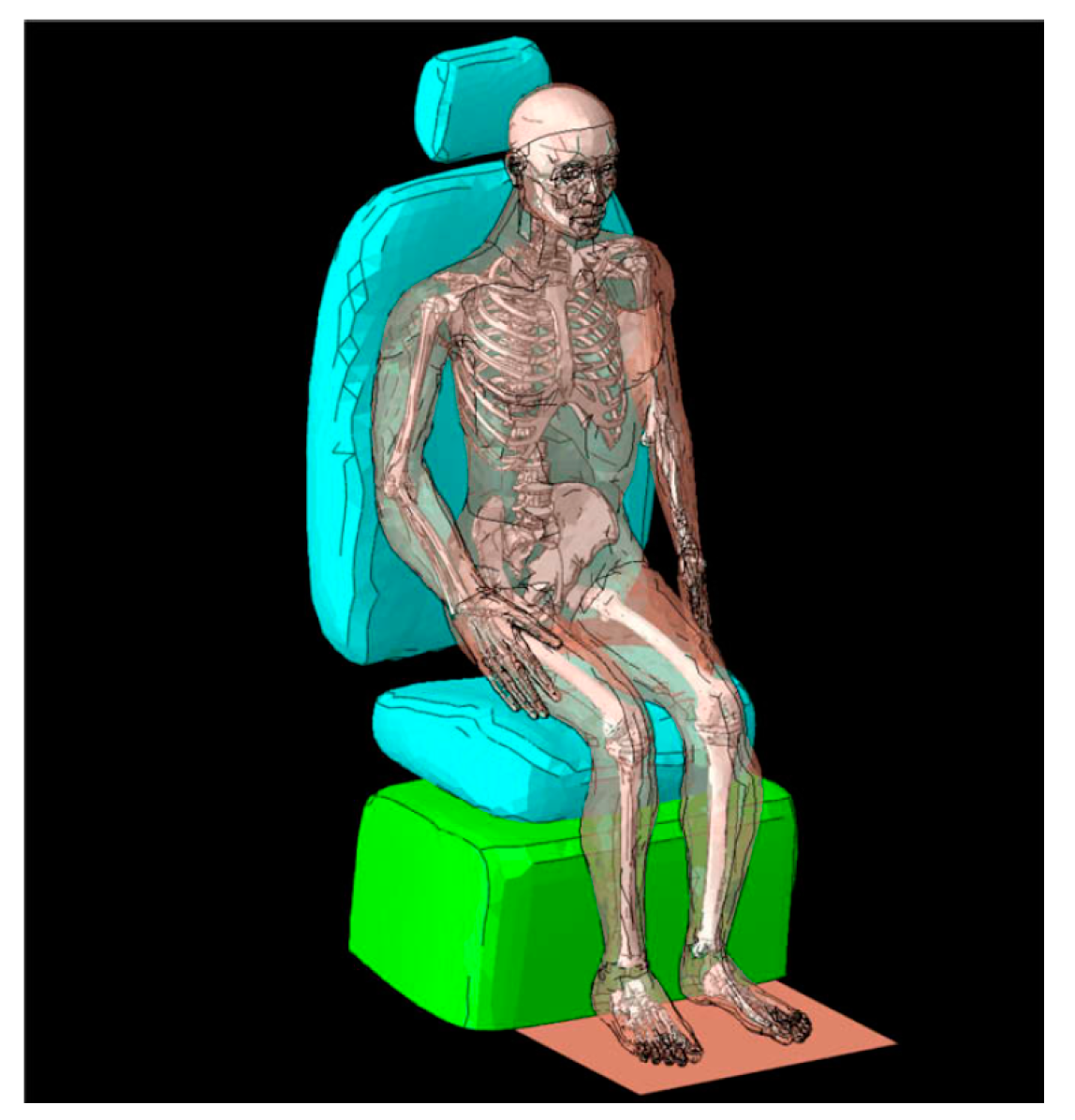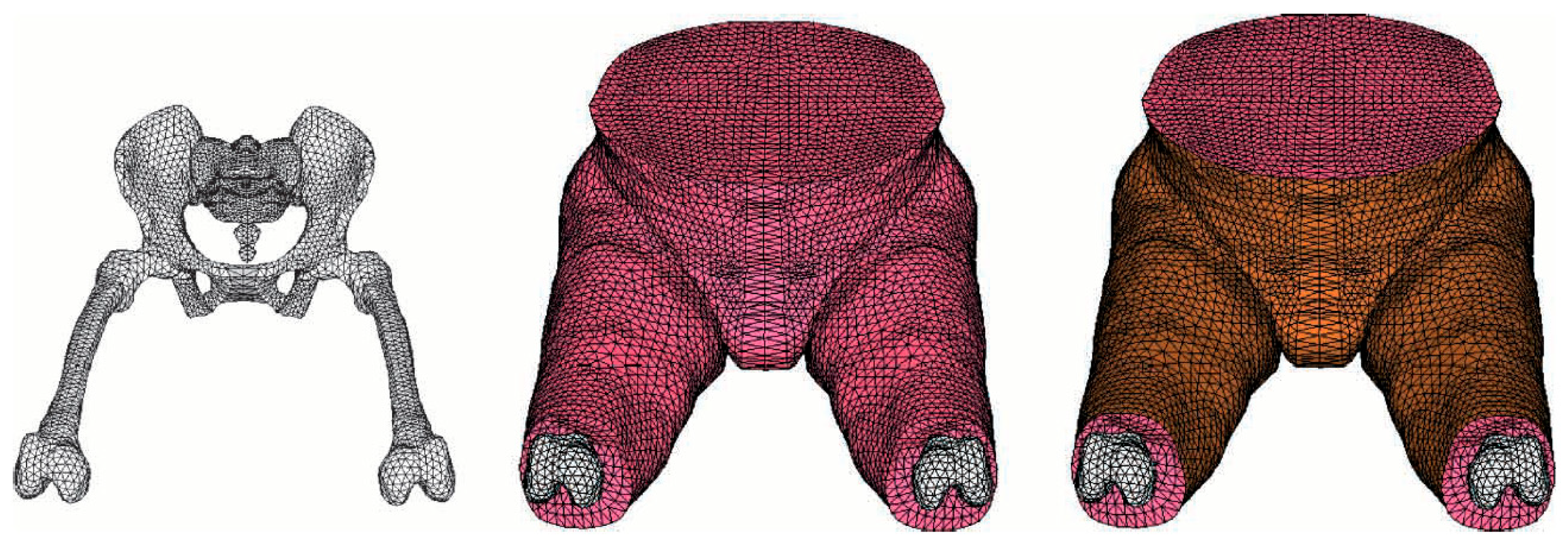Finite Element Methods for Modeling the Pressure Distribution in Human Body–Seat Interactions: A Systematic Review
Abstract
:1. Introduction
2. Methods
2.1. Literature Search Strategy
2.2. Study Selection
2.3. Data Extraction
3. Results
3.1. Search Results
3.2. Main Steps in FEA of Human–Seat Interactions
- (1)
- Acquiring data to build the proper geometry;
- (2)
- Creating the geometry of the model;
- (3)
- Applying material properties to different sections of the model;
- (4)
- Applying mesh elements on the different sections of the model;
- (5)
- Applying boundary conditions;
- (6)
- Processing the simulation to obtain results; and
- (7)
- Validating the obtained results.
3.2.1. Model Data Acquisition
3.2.2. Body Geometry
3.2.3. Material Properties
Skin Material Properties
Soft Tissue Material Properties
Bone Material Properties
Seat Foam Material Properties
3.2.4. Meshing
3.2.5. Boundary Conditions
3.2.6. Initial Condition
3.2.7. Validation
4. Discussions and Recommendations
Future Research Directions
5. Conclusions
Author Contributions
Funding
Institutional Review Board Statement
Informed Consent Statement
Data Availability Statement
Conflicts of Interest
Appendix A
| Reference | Interested Environment and Seat Type | Represented Population of the FE Model | Model Acquirement for the Human | Analyzed Aspects of Human–Seat Interaction Based on the FE Model |
|---|---|---|---|---|
| Modeling with the full human body | ||||
| Han 2021 [4] | Ride comfort simulation | Average Male | CAD, Rigid Human Body model | Modeling of a vehicle seat in a lumped network model for ride comfort simulation: •pressure distribution |
| Siefert 2019 [35] | Vehicle’s driver seat | 50th percentile male | CASIMIR | Analyzed the combined seat and ride comfort with vehicle vibration with the simulated •Seat transmissibility |
| Dong 2019 [16] | Seat with vertical white noise excitation | 50th percentile Chinese male | POSER and ANSA | Developed a model that can be used to simulate the biodynamic response, including the •Principal response frequency of the lumbar IVD |
| Kim 2017 [30] | General seat with designed cushion | 50th percentile European male | MADYMO | Obtained an optimal design of the seat cushion and back supporter preventing decubitus ulcer referring to the simulated •Interface pressure distribution |
| Guo 2016 [28] | Prolonged driving in the automobile seat | 50th percentile Chinese male | POSER | Found the optimal comfort lumbar support parameter referring to the simulations of the •pressure distribution •IVD stress |
| Huang 2015 [29] | Automotive seats | 50th percentile | Hybrid III 50th Male FE | Evaluated the seating comfort by simulating the •Pressure distribution •Contact shear stress distribution •Tissue’s internal stress distribution |
| Liu 2015 [2] | General rigid Seat with vertical vibration excitation | 50th percentile | CT Scans | Developed a human soft tissue model that can represent dynamic interaction with the seat surface considering the •Dynamic pressure distribution •Seat transmissibility variations |
| Du 2013 [17] | Automotive seats | 50th percentile Chinese male | 3D scanning-based surface model and POSER skeletal model | To improve the seat design and comfort, a posture-adjustable model was developed and used to simulate the: •Pressure distribution •Surface shear stress •Body’s tissue stress |
| Amer 2013 [40] | Validation study | different subjects tested | Anthropometric data | |
| Grujicic 2009 [1] | Automotive seats | Not mentioned, but AnyBody provides 50th percentile male model by default | AnyBody | Investigated the seating comfort based on the developed model by simulation of the •Pressure distribution |
| Siefert 2009 [34] | 50th percentile male, 95th percentile male, 5th percentile female. | Anthropometric data | ||
| Siefert 2008 [33] | Vehicle’s driver seat | 50th Percentile male | CASIMIR | Static and dynamic seating comfort regions were assessed based on the simulated •Pressure distribution •Seat transfer function |
| Siefert 2008 [18] | Automotive seats | 50th Percentile male | CASIMIR | Evaluated the seat regarding comfort and health referring to the simulation of the •pressure distribution |
| Pankoke 2007 [15] | automotive seats | 50th Percentile | CASIMIR | Static and dynamic seating comfort region were assessed based on the simulated •Pressure distribution •Seat transfer function |
| Modeling with specific body section | ||||
| Yadav 2021 [57] | Seat cushion comfort | 50th Percentile male | GHBMC (global human body models consortium) | Evaluated comfort and pressure ulcer creation: •Pressure distribution •Strain distribution •Stress distribution |
| Chen 2019 [22] | Effect of material Modeling on FEA results | US mid-size male and female | 3D scan, CT scan, Anthropometric measurements | Compared the effect of different hyperelastic models: •Ogden model •Mooney–Rivlin •Fung Model •neo-Hookean model |
| Kumar 2019 [42] | Cockpit seat of a flight simulator | 50th Percentile male | Taken from ‘open literature’ | Seating comfort at the thigh and buttock region and assessed based on the simulated •Pressure distribution |
| Xu 2019 [36] | Automotive seats | 50th Percentile | 3D Scan | Seating comfort in the thigh and buttock region was assessed based on the simulated •Pressure distribution |
| Katzengold 2019 [20] | Medical support platform | One male head | Visible Human (male) Project image database | Investigated head pressure ulcer prevention using a new head support based on the simulated •FEA simulation •Effective stress on the scalp skin •Shear stress on the scalp skin |
| Rhimi 2016 [32] | Prolonged driving in the automobile seat | 50th Percentile male | CAD | Found new seat design parameters that improved the comfort in the thigh and buttock region by investigating the •Equivalent stress of von-mises •Equivalent deformation |
| Peterson 2016 [50] | Prolonged sitting on the wheelchair | Single subject | MRI | Optimized the support interface at the thigh–buttock interface to reduce pressure ulcers based on •FEA simulation |
| Pennestrì 2015 [43] | Automotive seats | Different percentiles | Anthropometric data | Compared and discussed different approaches that predict the seat comfort of half of the full body based on the simulation of the •Pressure distribution •Acceleration frequency response •Pelvis acceleration signals |
| Mircheski 2014 [39] | Vehicle’s driver seat | 50th and 80th Percentile | CAD on CATIA | Seating comfort in the thigh and buttock region was assessed based on the simulated •Pressure distribution |
| Paul 2014 [19] | Automotive seats | 95th percentile male | Vitus Smart whole-body scanner, and MRI | Mechanical interactions between the thigh and buttock region and the seat were studied based on the simulated •Human–seat physical indentation |
| Zhang 2014 [38] | Car seat with vibration | 50th Percentile | CAD for a manikin | Investigated the dynamic interaction between the seat and human body in the thigh and buttock region by simulating the •Vibration transmissibility |
| Mohanty 2014 [23] | Prolonged sitting in office environment | male, 24 years, 165 cm, 70 kg | MRI | Investigated different seat conditions’ effect on reducing pressure ulcers in the thigh and buttock region. They simulated the •Von-mises stress distribution •Shear stress distribution |
| Li 2013 [24] | General sitting with a custom-contoured cushion | Specified body characteristic | MRI | Quantified the buttock comfort of a cushion by investigating the •Pressure distribution •Displacement |
| Oomens 2013 [25] | Spine board for patient with spine injuries | 3 female volunteers | MRI | Designed a new soft-layer spine board to mitigate pressure ulcers based on the simulation of the •Soft tissue strains |
| Hu 2013 [41] | Automotive seats | 296 men and 417 women | 3D scans | Assessed the fit of the torso relative to the backrest based on the simulated •Deformation distribution |
| Volpe 2012 [37] | Padded furniture (typical armchair) | Average male from PeopleSize 2000® | CAD using anthropometric data | Seating comfort in the thigh and buttock region was assessed based on the simulated •Pressure distribution |
| Paul 2012 [31] | Vehicle’s driver seat | 5th, 50th, 95th Percentile of Australian | Vitus Smart whole-body scanner | Investigated the interaction between the flexible seat components and the thigh and buttock section based on the •Cushion foam deflection •Underlying suspension deflection •Seat frame deflection |
| Carfagni 2007 [27] | Motorcycle saddle | 50th Percentile male | Modeled in CAD software based on anthropometric input | Seat comfort assessment in the thigh and buttock section based on the simulated •Pressure distribution |
| Cheng 2007 [21] | Seats in the fighter and tactile aircraft | 50th Percentile male | Bones: VAKHUM | Seating comfort in the thigh and buttock region was assessed based on the simulated •Pressure distribution |
| Makhsous 2007 [26] | Prolonged sitting on the wheelchair | 50th Percentile male | MRI | Evaluated pressure ulcers on the buttock based on the simulation of the •Pressure distribution •Internal pressure distribution •Von-Mises stress |
| Verver 2004 [44] | Automotive seats | Single subject | MADYMO 6.0 | Seating comfort in the buttock region was assessed based on the simulated •Pressure distribution |
Appendix B
| Reference | Initial Conditions |
|---|---|
| Volpe 2012 [37] | The human body FE model is placed above the seat cushion (distance of 0.1 mm) as the beginning point of the simulation. |
| Verver 2004 [44] | The human body FE model is placed ‘just above’ the seat cushion as the beginning point of the simulation. |
| Mircheski 2014 [39] | The human body FE model is placed above the seat cushion without contact as the beginning point of the simulation. |
| Carfagni 2007 [27] | The human body FE model is placed ‘just above’ the seat cushion as the beginning point of the simulation. |
| Hu 2013 [41] | The human body FE model is placed in front of the seat backrest cushion without contact as the beginning point of the simulation. Motion at about 0.1 m/s was prescribed onto the occupant model, moving towards the cushion to generate contact. |
| Dong 2018 [16] | The human body FE model is placed above the seat cushion without contact as the beginning point of the simulation. |
| Huang 2015 [29] | The human body FE model is placed above the seat cushion without contact as the beginning point of the simulation. |
| Siefert 2019 [35] | The human body FE model is placed above the seat cushion without contact as the beginning point of the simulation. |
| Du 2013 [17] | The human body FE model is placed above the seat cushion without contact as the beginning point of the simulation |
| Kumar 2019 [42] | The human body FE model is placed above the seat cushion without contact (with a distance of 10 mm) as the beginning point of the simulation |
| Siefert 2008 [33] | The human body FE model is placed above the cushion of the seat pan and backrest without contact as the beginning point of the simulation |
| Pankoke 2007 [15] | The human body FE model is placed above the cushion of the seat pan and backrest without contact as the beginning point of the simulation |
References
- Grujicic, M.; Pandurangan, B.; Arakere, G.; Bell, W.C.; He, T.; Xie, X. Seat-cushion and soft-tissue material modeling and a finite element investigation of the seating comfort for passenger-vehicle occupants. Mater. Eng. 2009, 30, 4273–4285. [Google Scholar] [CrossRef]
- Liu, C.; Qiu, Y.; Griffin, M.J. Finite element modelling of human-seat interactions: Vertical in-line and fore-and-aft cross-axis apparent mass when sitting on a rigid seat without backrest and exposed to vertical vibration. Ergonomics 2015, 58, 1207–1219. [Google Scholar] [CrossRef] [PubMed]
- Zhong, X.; Liu, Y.; Alawneh, O.; Faieghi, R.; Xi, F. Evaluation of Loadings in Head-Cervical-Thoracic Region for a Parameterized Aircraft Seat Backrest with Different Headrest Designs. In Proceedings of the 3rd International Comfort Congress 2021, Toronto, ON, Canada, 2–3 September 2021. [Google Scholar]
- Liu, Y.; Zhong, X.; Ghebreiyesus, W.; Ji, J.; Xi, F. Analysis and modeling of human seat interaction with a focus on the upper body and backrest using biomechanics and contact mechanics. Work 2021, 68, S161–S182. [Google Scholar] [CrossRef] [PubMed]
- Campos, G.H.; Xi, F. Pressure sensing of an aircraft passenger seat with lumbar control. Appl. Ergon. 2020, 84, 103006. [Google Scholar] [CrossRef]
- Autodesk. Autodesk Finite Element Analysis. Available online: https://www.autodesk.ca/en/solutions/finite-element-analysis#:~:text=Finite%20element%20analysis%20(FEA)%20is,the%20way%20it%20was%20designed (accessed on 1 April 2021).
- Toyota Motor Corporation and Toyota Central R&D Labs. THUMS Model. Available online: https://www.toyota.co.jp/thums/about/ (accessed on 1 April 2021).
- Yates, K.M.; Lu, Y.C.; Untaroiu, C.D. Statistical shape analysis of the human spleen geometry for probabilistic occupant models. J. Biomech. 2016, 49, 1540–1546. [Google Scholar] [CrossRef] [PubMed]
- Bohman, K.; Östh, J.; Jakobsson, L.; Stockman, I.; Wimmerstedt, M.; Wallin, H. Booster cushion design effects on child occupant kinematics and loading assessed using the PIPER 6-year-old HBM and the Q10 ATD in frontal impacts. Traffic Inj. Prev. 2020, 21, S25–S30. [Google Scholar] [CrossRef] [PubMed]
- Savonnet, L.; Wang, X.; Duprey, S. Finite element models of the thigh-buttock complex for assessing static sitting discomfort and pressure sore risk: A literature review. Comput. Methods Biomech. Biomed. Eng. 2018, 21, 379–388. [Google Scholar] [CrossRef] [Green Version]
- Robinette, K.M.; Blackwell, S.; Daanen, H.; Boehmer, M.; Fleming, S. Civilian American and European Surface Anthropometry Resource (Caesar), Final Report. Volume 1. Summary; Sytronics Inc.: Beavercreek, OH, USA, 2002. [Google Scholar]
- P Software. The Premier 3D Rendering & Animation Software. Available online: https://www.posersoftware.com/ (accessed on 1 April 2021).
- Siemens Digital Industries Software. MADYMO. Available online: https://tass.plm.automation.siemens.com/madymo (accessed on 1 April 2021).
- Rasmussen, J.; Damsgaard, M.; Surma, E.; Tørholm, S.; de Zee, M.; Vondrak, V. AnyBody—A software system for ergonomic optimization. In Proceedings of the Fifth World Congress on Structural and Multidisciplinary Optimization, Lido di Jesolo, Italy, 19–23 May 2003. [Google Scholar]
- Pankoke, S.; Siefert, A. Virtual Simulation of Static and Dynamic Seating Comfort in the Development Process of Automobiles and Automotive Seats: Application of Finite-Element-Occupant-Model CASIMIR; SAE International: Warrendale, PA, USA, 2007. [Google Scholar]
- Dong, R.-C.; He, L.; Du, W.; Cao, Z.-K.; Huang, Z.-L. Effect of sitting posture and seat on biodynamic responses of internal human body simulated by finite element modeling of body-seat system. J. Sound Vib. 2019, 438, 543–554. [Google Scholar] [CrossRef]
- Du, X.; Ren, J.; Sang, C.; Li, L. Simulation of the Interaction between Driver and Seat. Chin. J. Mech. Eng. 2013, 26, 1234–1242. [Google Scholar] [CrossRef]
- Siefert, A.; Pankoke, S.; Blüthner, R. Development of a Detailed Buttock and Thigh Muscle Model for the Dynamic Occupant Model CASIMIR. SAE Int. J. Passeng. Cars-Mech. Syst. 2008, 1, 1085–1093. [Google Scholar] [CrossRef]
- Paul, G.; Miller, J.; Pendlebury, J. Soft Tissue Human Thigh and Buttock Finite Element Model to Simulate Vehicle Seat Cushion Indentation; Inderscience Publishers Ltd.: Geneva, Switzerland, 2014; Volume 4, issue 3–4, pp. 220–232. [Google Scholar] [CrossRef]
- Katzengold, R.; Gefen, A. Modelling an adult human head on a donut-shaped gel head support for pressure ulcer prevention. Int. Wound J. 2019, 16, 1398–1407. [Google Scholar] [CrossRef] [PubMed]
- Cheng, Z.; Smith, J.A.; Pellettiere, J.A.; Fleming, S.M. Considerations and Experiences in Developing an FE Buttock Model for Seating Comfort Analysis. 2007. Available online: https://doi.org/10.4271/2007-01-2458 (accessed on 1 April 2021).
- Chen, S.; Scott, J.; Bush, T.R.; Roccabianca, S. Inverse finite element characterization of the human thigh soft tissue in the seated position. Biomech. Modeling Mechanobiol. 2020, 19, 305–316. [Google Scholar] [CrossRef] [PubMed]
- Mohanty, P.P.; Mahapatra, S.S. A finite element approach for analyzing the effect of cushion type and thickness on pressure ulcer. Int. J. Ind. Ergon. 2014, 44, 499–509. [Google Scholar] [CrossRef]
- Li, S.; Zhang, Z.; Wang, J.U.E. A new custom-contoured cushion system based on finite element modeling prediction. J. Mech. Med. Biol. 2013, 13, 1350051. [Google Scholar] [CrossRef]
- Oomens, C.W.J.; Zenhorst, W.; Broek, M.; Hemmesb, B.; Poezed, M.; Brink, P.R.G.; Baderae, D.L. A numerical study to analyse the risk for pressure ulcer development on a spine board. Clin. Biomech. 2013, 28, 736–742. [Google Scholar] [CrossRef]
- Makhsous, M.; Lim, D.; Hendrix, R.; Bankard, J.; Rymer, W.Z.; Lin, F. Finite Element Analysis for Evaluation of Pressure Ulcer on the Buttock: Development and Validation. IEEE Trans. Neural Syst. Rehabil. Eng. 2007, 15, 517–525. [Google Scholar] [CrossRef] [Green Version]
- Carfagni, M.; Governi, L.; Volpe, Y. Comfort assessment of motorcycle saddles: A methodology based on virtual prototypes. Int. J. Interact. Des. Manuf. 2007, 1, 155–167. [Google Scholar] [CrossRef]
- Guo, L.-X.; Dong, R.-C.; Zhang, M. Effect of lumbar support on seating comfort predicted by a whole human body-seat model. Int. J. Ind. Ergon. 2016, 53, 319–327. [Google Scholar] [CrossRef]
- Huang, S.; Zhang, Z.; Xu, Z.; He, Y. Modeling of human model for static pressure distribution prediction. Int. J. Ind. Ergon. 2015, 50, 186–195. [Google Scholar] [CrossRef]
- Kim, H.; Lee, T.; Lee, Y.; Kim, J.; Jung, S.; Yang, D.; Hong, J. A design for seat cushion and back-supporter using finite element analysis for preventing decubitus ulcer. J. Biomech. Sci. Eng. 2017, 12, 16–00586. [Google Scholar] [CrossRef] [Green Version]
- Paul, G.; Pendlebury, J.; Miller, J. The contribution of seat components to seat hardness and the interface between human occupant and a driver seat. Int. J. Hum. Factors Model. Simul. 2012, 3, 378–397. [Google Scholar] [CrossRef]
- Rhimi, A. Concepts for the reduction of the discomfort generated by the prolonged static posture during the driving task, part II: Experiments and validations. Int. J. Ind. Ergon. 2017, 57, 55–62. [Google Scholar] [CrossRef]
- Siefert, A.; Pankoke, S.; Wölfel, H.P. Virtual optimisation of car passenger seats: Simulation of static and dynamic effects on drivers’ seating comfort. Int. J. Ind. Ergon. 2008, 38, 410–424. [Google Scholar] [CrossRef]
- Siefert, A.; Pankoke, S.; Hofmann, J. CASIMIR/Automotive: A Software for the virtual Assessment of Static and Dynamic Seating Comfort. In Proceedings of the Digital Human Modeling for Design and Engineering Conference and Exhibition, Gothenburg, Sweden, 6–11 June 2009. [Google Scholar]
- Siefert, A.; Hofmann, J.; Veeraraghavan, A.; Lu, Y. Numerical Methods for Combined Analysis of Seat and Ride-Comfort; SAE Technical Paper 2019-01-0404; SAE International: Warrendale, PA, USA, 2019. [Google Scholar] [CrossRef]
- Xu, W.; Zeng, Y.; Ye, J. Study on Virtual Simulation Method of Driver Seat Comfort. IOP Conf. Series Mater. Sci. Eng. 2019, 493, 12096. [Google Scholar] [CrossRef]
- Volpe, Y.; Governi, L.; Furferi, R. A Computational Model for Early Assessment of Padded Furniture Comfort Performance. Hum. Factors Ergon. Manuf. Serv. Ind. 2012, 25, 90–105. [Google Scholar] [CrossRef]
- Zhang, X.; Qiu, Y.; Griffin, M.J. Developing a simplified finite element model of a car seat with occupant for predicting vibration transmissibility in the vertical direction. Ergonomics 2015, 58, 1220–1231. [Google Scholar] [CrossRef]
- Mircheski, I.; Kandikjan, T.; Sidorenko, S. Comfort analysis of vehicle driver’s seat through simulation of the sitting process. Teh. Vjesn. 2014, 21, 291–298. [Google Scholar]
- Amer, S.; Onyebueke, L. Experimental Validation of the Computer Aided Design Technique for Seat Comfort Design and Evaluation; SAE Technical Paper 2013-01-0448; SAE International: Warrendale, PA, USA, 2013. [Google Scholar] [CrossRef]
- Hu, J.; Reed, M.P. Development of a Methodology for Simulating Seat Back Interaction Using Realistic Body Contours. SAE Int. J. Passeng. Cars. Mech. Syst. 2013, 6, 623–628. [Google Scholar] [CrossRef] [Green Version]
- Kumar, V.; Mishra, R.K.; Krishnapillai, S. Study of pilot’s comfortness in the cockpit seat of a flight simulator. Int. J. Ind. Ergon. 2019, 71, 1–7. [Google Scholar] [CrossRef]
- Pennestri, E.; Valentini, P.P.; Vita, L. Comfort analysis of car occupants: Comparison between multibody and finite element models. Int. J. Veh. Syst. Model. Test. 2005, 1, 68–78. [Google Scholar] [CrossRef] [Green Version]
- Verver, M.M.; van Hoof, J.; Oomens, C.W.J.; Wismans, J.S.H.M.; Baaijens, F.P.T. A Finite Element Model of the Human Buttocks for Prediction of Seat Pressure Distributions. Comput. Methods Biomech. Biomed. Eng. 2004, 7, 193–203. [Google Scholar] [CrossRef] [PubMed]
- Dabnichki, P.A.; Crocombe, A.D.; Hughes, S.C. Deformation and stress analysis of supported buttock contact. Proc. Inst. Mech. Eng. Part H J. Eng. Med. 1994, 208, 9–17. [Google Scholar] [CrossRef]
- Reilly, D.T.; Burstein, A.H.; Frankel, V.H. The elastic modulus for bone. J. Biomech. 1974, 7, 271–275. [Google Scholar] [CrossRef]
- Todd, B.A.; Thacker, J.G. Three-dimensional computer model of the human buttocks, in vivo. J. Rehabil. Res. Dev. 1994, 31, 111. [Google Scholar] [PubMed]
- Deng, B. Measuring and Modeling Force-Deflection Responses of Human Thighs in Seated Postures; Department of Material Science and Mechanics, Michigan State University: East Lansing, MI, USA, 1994. [Google Scholar]
- Abeyaratne, R. Continuum Mechanics. 2012. Available online: http://web.mit.edu/abeyaratne/lecturenotes.html (accessed on 1 April 2021).
- Peterson, J.M.; Healey, C.P.; Visser, G.J.; Crombie, C.; Ledet, E.H. Pressure Ulcer Prevention: Optimizing a Temporally Redistributing Support Interface. Am. J. Eng. Appl. Sci. 2016, 9, 1222–1231. [Google Scholar] [CrossRef] [Green Version]
- Medical, V. BodiTrack2 ed. 2021. Available online: https://www.boditrak.com (accessed on 1 September 2021).
- Tekscan. Pressure Mapping. Force Measurement & Tactile Sensors. Available online: https://www.tekscan.com/ (accessed on 1 April 2021).
- XSENSOR. Intelligent Dynamic Sensing. Available online: https://www.xsensor.com/?utm_term=flexible%20pressure%20sensor&utm_campaign=XSENSOR+-+SENSORS&utm_source=adwords&utm_medium=ppc&hsa_acc=6428935425&hsa_cam=7420679214&hsa_grp=80564445563&hsa_ad=424413785419&hsa_src=g&hsa_tgt=kwd-296042834547&hsa_kw=flexible%20pressure%20sensor&hsa_mt=b&hsa_net=adwords&hsa_ver=3&gclid=Cj0KCQjwsLWDBhCmARIsAPSL3_2q64rm2RKh6h3RPHjckwr24qupEEVMPh3hxCHXn5ebDk7kLEyqOsQaAm0LEALw_wcB (accessed on 1 April 2021).
- Delp, S.L.; Anderson, F.C.; Arnold, A.S.; Loan, P.; Habib, A.; John, C.T.; Guendelman, E.; Thelen, D.G. OpenSim: Open-Source Software to Create and Analyze Dynamic Simulations of Movement. IEEE Trans. Biomed. Eng. 2007, 54, 1940–1950. [Google Scholar] [CrossRef] [Green Version]
- Rasmussen, J.; Tørholm, S.; de Zee, M. Computational analysis of the influence of seat pan inclination and friction on muscle activity and spinal joint forces. Int. J. Ind. Ergon. 2009, 39, 52–57. [Google Scholar] [CrossRef]
- Efe, H.; Kasal, A.; Kılıç, H.; Ozcan, C. Effect of the Critical Ergonomics Parameters on Domestic Chairs for Comfort using the Human Based Product Development Software. In Proceedings of the XXVIIth International Conference Research for Furniture Industry, Ankara, Turkey, 19–20 September 2015. [Google Scholar]
- Yadav, S.K.; Huang, C.; Mo, F.; Li, J.; Chen, J.; Xiao, Z. Analysis of seat cushion comfort by employing a finite element buttock model as a supplement to pressure measurement. Int. J. Ind. Ergon. 2021, 86, 103211. [Google Scholar] [CrossRef]





Publisher’s Note: MDPI stays neutral with regard to jurisdictional claims in published maps and institutional affiliations. |
© 2022 by the authors. Licensee MDPI, Basel, Switzerland. This article is an open access article distributed under the terms and conditions of the Creative Commons Attribution (CC BY) license (https://creativecommons.org/licenses/by/4.0/).
Share and Cite
Alawneh, O.; Zhong, X.; Faieghi, R.; Xi, F. Finite Element Methods for Modeling the Pressure Distribution in Human Body–Seat Interactions: A Systematic Review. Appl. Sci. 2022, 12, 6160. https://doi.org/10.3390/app12126160
Alawneh O, Zhong X, Faieghi R, Xi F. Finite Element Methods for Modeling the Pressure Distribution in Human Body–Seat Interactions: A Systematic Review. Applied Sciences. 2022; 12(12):6160. https://doi.org/10.3390/app12126160
Chicago/Turabian StyleAlawneh, Obidah, Xianzhi Zhong, Reza Faieghi, and Fengfeng Xi. 2022. "Finite Element Methods for Modeling the Pressure Distribution in Human Body–Seat Interactions: A Systematic Review" Applied Sciences 12, no. 12: 6160. https://doi.org/10.3390/app12126160
APA StyleAlawneh, O., Zhong, X., Faieghi, R., & Xi, F. (2022). Finite Element Methods for Modeling the Pressure Distribution in Human Body–Seat Interactions: A Systematic Review. Applied Sciences, 12(12), 6160. https://doi.org/10.3390/app12126160







